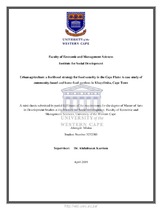| dc.description.abstract | Growing urban food insecurity has prompted many researchers, NGOs, international agencies and governments to advocate for urban agriculture as a livelihood strategy to improve the household food security of the urban poor. Urban agriculture is an instrument for ensuring greater food security and a livelihood strategy for urban households. In South Africa increased attention on urban agriculture is triggered by current trends of urbanization, economic instability, high unemployment rates among the urban poor, and high food prices. Unemployment and urban food insecurity are high in low-income areas. In the Cape Flats, households with no or little disposable income, are food insecure and vulnerable to food insecurity. Income and wage employment are the main determinants of food security in urban areas. However, urban agriculture projects by two NGOs assist communities to be resourceful. Abalimi Bezekhaya, an NGO assists individuals and communities to start and maintain their own community gardens while Soil for Life promotes home food gardens. Abalimi Bezekhaya and Soil for Life seek to address the urban challenge by promoting self-sustained agriculture for food security and livelihoods. There has, however, been little empirical evidence suggesting that urban agriculture projects improve the food security and livelihoods of participants. This study assessed the potential of urban agriculture to address food security, examined the ways in which agriculture is used as a livelihood strategy for household food security, determined other livelihood strategies and coping mechanisms assumed by gardeners to become food secure, and demonstrates the contribution of NGOs in promoting agriculture in poor urban areas. Furthermore, this study addressed the following research questions: do community and household gardens provide a way of improving food and nutrition security and in what way are these impacts observable within participating households.
The research followed a mixed-method methodology. The literature is mapped out using international and local papers and empirical evidence collected on the subject. This study used the sustainable livelihoods approach as the theoretical lens through which to analyse the ways in which urban agriculture can be used as a viable livelihood strategy by urban gardeners. It also classified the constraints and opportunities, assets accessible, policies and institutions that exist, livelihood strategies and outcomes of the urban gardeners.
The findings of the study reveal that community and home gardens contribute moderately to livelihoods and food security in Khayelitsha. The results also reveal that 85% of the gardeners were either moderately or severely food insecure. Furthermore, 76.67% of gardeners purchased their food from supermarkets and local shops. Urban agriculture therefore plays a supplementary role in addressing household food security in Khayelitsha. The potential of community and home gardens to contribute to urban household food security and livelihoods is limited access to land and government assistance. There is a need for the City of Cape Town and the Department of Agriculture to assist and strengthen the practice of community and home gardens in Khayelitsha. | en_US |

